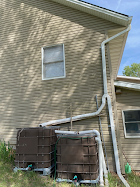by Sister Cathy Vetter, CCVI
The weather in mid-Missouri was delightful today to be outside so I decided to celebrate Earth Day helping my sister JoAnn and her husband Jim in their garden.
Jo was a biology teacher and organic gardener for over 50 years now. She learned a lot from our dad who had organic gardening books that are surely some of the first. Daddy was not raised on a farm but he certainly was always careful about caring for the earth. Jim has a love of gardening and he brings the expertise of knowing a lot about water and how to protect it, see that it is used well, understanding the way it flows and needs to be managed.At their home near New Bloomfield, MO they have an organic garden that includes annual crops as well as fruit trees, elderberry bushes, blueberry bushes, grapes, native nut trees and a variety of plants to attract bees, butterflies and other pollinators.
Jim has devised a system of collecting rain water from the roof of the house so that they can water the plants as well as preserve water.
Their composting of all organic matter continues to fertilize the gardens as well as eliminate unnecessary waste materials going into landfills.
Jo has a very active greenhouse on the south side of their passive solar home. During the winter months in Missouri when we have ice outside, she has continued to grow tomatoes, lettuce, spinach,
broccoli and other vegetables that they eat fresh. The greenhouse is also a perfect place to plant seeds early in February and March so that by the time the temperatures allow for plants in the garden, she has young tomato, squash, sweet potato, etc. plants that can be transplanted into the outdoor garden.
Today was a day to plant fruits and vegetables that are “above ground crops” so we planted pole bean seeds as well as tomatoe plants. The Almanac gives advice on when to plant what kinds of crops according to the phases of the moon. Many farmers rely on that advice and it seems to be helpful for good crops.
broccoli and other vegetables that they eat fresh. The greenhouse is also a perfect place to plant seeds early in February and March so that by the time the temperatures allow for plants in the garden, she has young tomato, squash, sweet potato, etc. plants that can be transplanted into the outdoor garden.
Today was a day to plant fruits and vegetables that are “above ground crops” so we planted pole bean seeds as well as tomatoe plants. The Almanac gives advice on when to plant what kinds of crops according to the phases of the moon. Many farmers rely on that advice and it seems to be helpful for good crops.
Some of the plants Jo and Jim already have growing in the garden include cucumbers, onions, carrots, peas, Brussels sprouts, broccoli, asparagus, spinach.
I took a few pictures of our time working in the garden today as well as a photo of the water system collecting water from the roof whenever it rains and an outdoor view of the greenhouse.
Caring for the earth, learning to eat healthy foods fresh from our own gardens and just appreciating the sunshine, fresh air, community time together, and satisfaction of working in healthy ways to provide for our food is a great way to celebrate Earth Day with family and friends. So glad I had this opportunity today. AND so glad I will be able to enjoy sharing in the fruits of this labor as we harvest - spinach and asparagus are already available in their garden.
Caring for the earth, learning to eat healthy foods fresh from our own gardens and just appreciating the sunshine, fresh air, community time together, and satisfaction of working in healthy ways to provide for our food is a great way to celebrate Earth Day with family and friends. So glad I had this opportunity today. AND so glad I will be able to enjoy sharing in the fruits of this labor as we harvest - spinach and asparagus are already available in their garden.






No comments:
Post a Comment